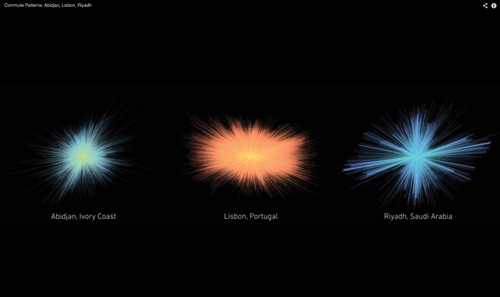COMMUTING TIMES STAY CONSTANT FOR COMMUTERS EVEN AS DISTANCES CHANGE
RESEARCH ON URBAN MOBILITY SHOWS HOW TRANSPORTATION
OPTIONS LET COMMUTERS LIMIT TIME IN TRANSIT.
Written by Peter Dizikes
Massachusetts Institute of Technology

Photo: Thinkstock
The data show that in the Ivory Coast morning commutes average just under 80 minutes regardless of distance, while in the Boston area, morning commutes range from 50 to 60 minutes, again across many distances, highways and urban areas.
By contrast, using GPS data in a location where automobiles are the only realistic commuting option, Riyadh, Saudi Arabia, the researchers found that the amount of time spent commuting did, in fact, correlate to the distance traveled: The further commuters had to go by car, the longer it took them.
In Riyadh, only 2 percent of commuting trips were on public transport and the average morning commute was about 50 minutes for trips of 5 to 20 kilometers, but increased to about 65 minutes for commutes of 20 to 40 kilometers.
People adapt
The researchers also used GPS data to study automobile based commutes in Milan, Italy. There, the morning commutes of drivers increased from 40 minutes, for those traveling up to 10 kilometers, to 60 minutes for those traveling 10 to 20 kilometers, and more than 80 minutes for those traveling 20 to 40 kilometers.
As in Riyadh, driving distance related to time spent in the vehicle although data from all forms of commuting, Milan also has suburban rail lines for instance, would be needed to characterize the overall pattern of commuting in the area.
The researchers believe the findings may have practical applications for urban planners and designers, especially knowing that commuters will use a variety of transportation options to stabilize their commute times rather than insisting on driving to work.
“It suggests that in places that have a lot of different transportation options available, this [limit on time] holds quite well,” Greco says. “In places that lean in one direction, as in car cultures for example, we saw a stronger association between distance and time.” Sobolevsky adds: “People try to adapt to their situations.”
The research also gives some support to a hypothesis, published by Italian physicist Cesare Marchetti in the 1990s, that humans have universally had commute times of about an hour throughout history. Because the new findings show commute times varying across countries, but having regular patterns within those countries, the co-authors in the paper say the data represents the “localized form” of Marchetti’s idea.
Scholars say the paper adds to our knowledge of commuter behavior. Filippo Simini, a lecturer on the Faculty of Engineering at the University of Bristol, in Great Britain, says the research is an "important contribution" to the question of how people allocate time for travel. Recognizing the greater significance commuters give to time rather than distance, Simini adds, "may have a significant influence on both human mobility modeling, prompting a shift from distance-based to time-based descriptions and on practical applications in urban and transportation planning."
The researchers suggest that additional studies with more granular phone data could further refine the broad patterns found in their research.
“When cities in general take survey approaches to understand how people move, these are fraught with inaccuracies, and they’re inconsistent from country to country,” Greco says. “If you can standardize that measurement procedure it becomes much easier to look at how people move on global level.”
The study is part of a larger research project sponsored by mobile equipment manufacturer Ericsson that is being conducted by the Senseable City Lab.

These maps show morning commute profiles across three cities: Abidjan, Ivory Coast; Lisbon, Portugal; and Riyadh, Saudi Arabia. All home locations have been aligned to a central point to show the variability of distance and direction among the cities over the same time period. MIT Senseable City Lab
© 2014 TLC Magazine Online, Inc. |